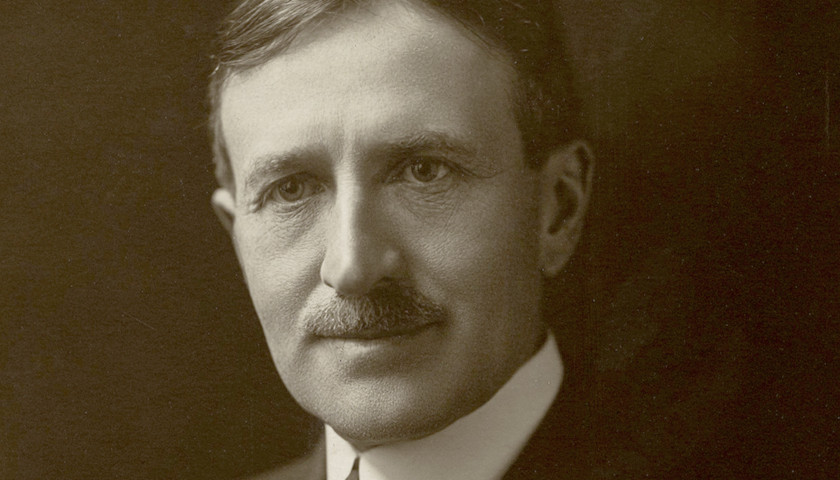Harvey S. Firestone was born on December 20, 1868 in Columbiana, Ohio to a family of farmers who had resided in the region since the early 19th century. He was an Ohio farm boy who went on to become one of the greatest industrialists of the modern world.
His career in the automobile industry started when he landed a job with his uncle’s buggy company, Columbiana Buggy Company. Firestone excelled in salesmanship and was promoted to manager of the company’s Michigan district. He moved to Detroit in 1892, but the business went bankrupt a few years later.
Firestone concluded that the future was in tires rather than carriages and set out on fulfilling his dream of replacing steel-rim wheels with rubber tires. He founded his first rubber tires company in 1896 in Chicago, Illinois, but sold the company in 1899 and pocketed $40,000 from the sale. He took the money and his patent for fastening rubber to steel carriage wheels and moved to Akron, Ohio, which he would help turn into the “rubber capital of the world.”
In 1900, the Firestone Rubber and Tire Company was born, but it wasn’t necessarily an immediate success. At first, Firestone relied on other companies to manufacture the rubber, according to the Ohio History Connection. His firm simply attached the rubber to steel wheels. By 1903, the Firestone company decided to manufacture its own rubber.
“Capital isn’t that important in business. Experience isn’t that important. You can get both of these things. What is important is ideas,” Firestone said, according to an account of his life published by his company.
So Firestone searched for ideas, and by the summer of 1904 he reached a breakthrough when the company developed the first “mechanically-fastened, straight-sided pneumatic automobile tire.” The first pneumatic suspension device was a “rubber suspension filled with air that eliminated body roll when rounding corners and absorbed bumps in the road,” the Firestone company explains. Automobile tycoon Henry Ford placed an order for 2,000 sets of the new tires in 1906 in what was the largest order for tires in the automobile industry to date.
It was also the beginning of a business partnership and close friendship that would last until the end of Firestone’s life. Some accounts claim that Firestone and Ford actually met once before in 1906 when Firestone was working for his uncle.
Indy 500
Firestone was an expert marketer and harnessed the popularity of the new sport of racing to his company’s advantage. In 1908, Firestone created the first all-rubber, non-skid tire. Fast-forward three years and the winner of the inaugural Indy 500, Ray Harroun, was driving a Firestone-equipped car to victory on May 30, 1911.

“Today, the driver knows that his victory in the race and his life depends to a great extent upon how good his tires are,” Firestone said later in his life. The Firestone brand’s association with the race correlated with a spike in sales the morning after race day. This was the beginning of the “win on Sunday, sell on Monday” mantra that has come to define modern NASCAR races.
By 1913, the Firestone Tire and Rubber Company’s sales topped $15 million, up from $100,000 in sales during its first year of operation. Firestone Tire and Rubber Company was now considered a member of the “Big Five” of the tire industry, which included companies like Goodyear and Goodrich, according to Harvard Business School.
A 1907 innovation of the “dismountable rim” also contributed to Firestone’s success. The creation allowed the rubber wheel and steel tire to be removed together, paving the way for the spare tire.
The Vagabonds

Between 1915 and 1924, Firestone and Ford took a number of “auto-camping” trips with Thomas Edison and naturalist John Burroughs, and called themselves the Four Vagabonds. They were often accompanied by a number of other guests, and in one case President Warren Harding joined an excursion to Maryland. During a 1924 trip, the men visited President Calvin Coolidge at his home in Vermont.
“They enjoyed the services of drivers and attendants to pitch their tents. They roughed it with the most modern conveniences, including battery-powered lighting arranged by Edison. Ford’s personal chef prepared meal,” Paul Dickson and William Hickman write in Firestone: A Legend, a Century, a Celebration.

The trips were discontinued by the mid-1920s because of the public attention they attracted but were no doubt a time of inspiration for Firestone and his peers. It was during the Vagabond-era that Firestone created the balloon tire, which became the industry standard.
In 1918, during World War I, Firestone “paved the way for innovation in shipping” by promoting the “Ship by Truck” campaign, similar to the “Put the Farm on Rubber” marketing campaign he would employ during the Great Depression. It’s safe to assume Firestone considered the rise of the trucking industry as good for business.
One of his final retail innovations was the launch of one-stop service stations called Firestone Tire and Service Centers, now named Firestone Complete Auto Care. The service stores began opening in 1926 while Firestone was producing more than 10 million tires a year and accounted for one-fourth of the American tire industry.
“When we consider the future of transportation and the part that rubber tires will play in the new scheme of things, the opportunities of the Firestone organization become almost too big to grasp,” Firestone said during a 1917 sales convention.
According to his New York Times obituary, Firestone died in his sleep on February 7, 1938 in Miami Beach, Florida at the age of 69.
– – –
Anthony Gockowski is managing editor of Battleground State News, The Ohio Star, and The Minnesota Sun. Follow Anthony on Twitter. Email tips to [email protected].




